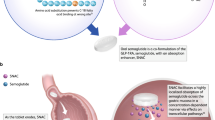Abstract
Carboxyamido-triazole (CAI) is an anti-invasive, antimetastatic, antiangiogenic agent in clinical development for cancer treatment. It has been postulated that food might enhance the oral absorption of micronized CAI based on an apparent discrepancy in steady state maximum concentrations when taken without regard to meals vs. fasting. The purpose of this study was to determine if a standardized meal affects the absorption and pharmacokinetics of this agent. Twelve patients with refractory cancers and good end organ function were randomized to receive two doses of CAI (250 mg/m 2 ) with and without a standardized high fat meal. One cohort of 6 patients received these doses at 9 AM, and the remaining 6 patients received CAI at 9 PM. Blood was obtained prior to each dose, and serially thereafter. A series of pharmacokinetic (PK) models were fit to the concentration–time data. PK parameters were ultimately calculated using a model which allows simultaneous estimation of parameters from both test doses using nonlinear least squares analysis with ADAPT II. This model estimates independent absorption rate constants and relative fraction absorbed for each condition. AUC 0–t was determined using the trapezoidal method, extrapolated to infinity, and used to calculate the relative bioavailability. No significant differences in PK parameters were noted between the morning and evening cohorts. However, the relative bioavailability, as measured by AUC 0–∞, of CAI was significantly increased when administered with a high fat meal compared to fasting (138.9 vs. 52.2 μg * hr/ml; p=0.0005). The magnitude of the increase in relative bioavailability of CAI taken with food could have profound implications for patients who may inadvertently take this medication shortly after eating.
Similar content being viewed by others
REFERENCES
E. C. Kohn and L. A. Liotta. L651582: a novel antiproliferative and antimetastasis agent. J. Natl. Cancer Inst. 82:54–60 (1990).
W. J. Wasilenko, A. J. Palad, K. D. Somers, P. F. Blackmore, E. C. Kohn, J. S. Rhim, G. L. Wright, and P. F. Schellhammer. Effect of the calcium influx inhibitor carboxyamido-triazole on the proliferation and invasiveness of human prostate tumor cell lines. Int. J. Cancer 68:259–264 (1996).
P. A. Lambert, K. D. Somers, E. C. Kohn, and R. R. Perry. Antiproliferative and antiinvasive effects of carboxyamido-triazole on breast cancer cell lines. Surgery 122:372–379 (1997).
E. C. Kohn, R. Alessandro, J. Spoonster, R. P. Wersto, and L. A. Liotta. Angiogenesis: Role of calcium-mediated signal transduction. Proc. Natl. Acad. Sci. U.S. 92:1307–1311 (1995).
E. C. Kohn, W. Jacobs, Y. S. Kim, R. Alessandro, W. G. Stetler-Stevenson, and L. A. Liotta. Calcium influx modulates expression of matrix metalloproteinase-2 (72-kDa type IV colagenase, gelatinase A)*. J. Biol. Chem. 269:21505–21511 (1994).
E. C. Kohn, E. Reed, G. A. Sarosy, M. Christian, C. J. Link, K. Cole, W. D. Figg, P. A. Davis, J. Jacob, B. Goldspiel, and L. A. Liotta. Clinical investigation of a cytostatic calcium influx inhibitor in patients with refractory cancers. Cancer Res. 56:569–573 (1996).
J. Berlin, K. D. Tutsch, P. Hutson, J. Cleary, R. P. Rago, R. Z. Arzoomanian, D. Alberti, C. Feierabend, and G. Wilding. Phase I clinical and pharmacokinetic study of oral carboxyamidotriazole, a signal transduction inhibitor. J. Clin. Oncol. 15:781–789 (1997).
E. C. Kohn, W. D. Figg, G. A. Sarosy, K. S. Bauer, P. A. Davis, M. J. Soltis, A. Thompkins, L. A. Liotta, and E. Reed. Phase I trial of micronized formulation carboxyamidotriazole in patients with refractory solid tumors: pharmacokinetics, clinical outcome, and comparison of formulations. J. Clin. Oncol. 15:1985–1993 (1997).
J. Berlin, K. D. Tutsch, R. Z. Arzoomanian, D. Alberti, C. Feierabend, K. Simon, P. Hutson, J. Cleary, J. Stewart, and G. Wilding. Phase I clinical and pharmacokinetic trial of an oral micronized formulation of carboxyamidotriazole (CAI). Proc. Am. Assoc. Cancer Res. 37:164 (al133) (1996).
B. R. Simmons, K. S. Bauer, N. A. McCall, E. C. Kohn, and W. D. Figg. An optimized method for the quantitation of carboxyamido-triazole (CAI) in human plasma with solid phase extraction and reversed phase HPLC. Anal. Lett. 30:2009–2021 (1997).
M. Gibaldi and D. Perrier. Pharmacokinetics, 2nd ed., Dekker, New York (1982).
D. Z. D'Argenia and A. Schumitzky. A program package for simulation and parameter estimation in pharmacokinetic systems. Comput. Prog. Biomed. 9:115–134 (1979).
K. Yamaoka, J. Nakagawa, and T. Uno. Application of Aikaike's information criteria (AIC) in the evaluation of linear pharmacokinetic equations. J. Pharmacokin. Biopharm. 2:165–175 (1978).
G. G. Koch. The use of non-parametric methods in the statistical analysis of the two-period change-over design. Biometrics 28:577–584 (1972).
Y. Hochberg. A sharper Bonferroni procedure for multiple tests of significance. Biometrika 75:800–802 (1988).
L. K. Ludden, J. M. Strong, E. C. Kohn, and J. M. Collins. Similarity of metabolism for CAI (NSC 609974) in human liver tissue in vitro and in humans in vivo. Clin. Cancer Res. 1:399–405 (1995).
Author information
Authors and Affiliations
Rights and permissions
About this article
Cite this article
Bauer, K.S., Kohn, E.C., Lush, R.M. et al. Pharmacokinetics and Relative Bioavailability of Carboxyamido-Triazole with Respect to Food and Time of Administration: Use of a Single Model for Simultaneous Determination of Changing Parameters. J Pharmacokinet Pharmacodyn 26, 673–687 (1998). https://doi.org/10.1023/A:1020750923542
Published:
Issue Date:
DOI: https://doi.org/10.1023/A:1020750923542




